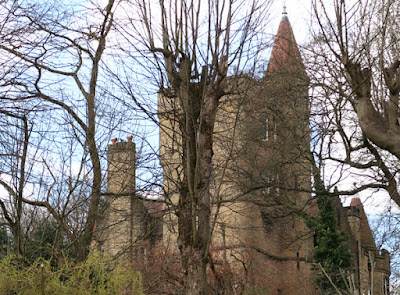 |
| Pebbles in the Chatsworth Grit |
For my next day out in April 2022, after my further investigation of Loxley Edge and Wadsley Common, the spring weather encouraged me to extend the length of my walks and, in preparation for my forthcoming illustrated talk to the Ranmoor Society, I decided to undertake some further investigations of the area.
As usual, I planned my walk to include buildings on the British Listed Buildings website that did yet have a photograph, which I assumed would provide very many examples of the use of locally quarried building stones for the buildings, boundary walls, roads and pavements.
Taking the No. 51 bus from Arundel Gate in Sheffield and alighting at the Sandygate Road/Coldwell Lane stop, the first building on my list was the lodge to the Towers (1896), built in the Scottish Baronial style to the design of Flockton and Gibbs – an architectural practice whose work I was now quite familiar with, from my investigations of the historic architecture of Sheffield.
When taking a couple of photos from the opposite side of the road, I could quite clearly see the uncoursed rubble masonry, which is quite an unusual style that I can only recall seeing before at St. Mark’s church hall in Grenoside and Whiston Methodist Church.
Crossing the road to take a closer look, it was immediately obvious that the lodge and the boundary walls are built in coarse grained Chatsworth Grit, which outcrops along the nearby Rivelin Valley. Old Ordnance Survey maps and the new Building Stones Database for England record several quarries in the area, but most of them are no longer visible.
I was very surprised to see that several blocks used for the rubble walls are actually face bedded, with fingernail sized pebbles being exposed in exactly the same way that I had seen many times on natural bedding planes, when surveying the RIGS (Regionally Important Geological Sites) in the Peak District National Park and since walking along the gritstone edges in Derbyshire.
Although the quoins to the entrance to The Towers have been obviously squared and tooled, the pebbly blocks show no sign of tool marks whatsoever. On a previous trip to Roundhay Park with the Sheffield U3A Geology Group, I learned that beds such as these were formed by the larger stones being rolled around in underwater sand dunes in the channels of a large river delta - approximately 315 million years ago.
The Towers itself is set on private land, which is only visible from the road that leads up to the houses that have since been built alongside it. I just took a few quick snaps of the parts of the building that I could see, which I presume is also built out of the Chatsworth Grit and then continued my investigation of Sandygate Road and Redmires Road.








No comments:
Post a Comment